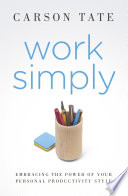

In 'Work Simply,' the author emphasizes the importance of clarity in our work processes. Complexity can lead to confusion, stress, and inefficiency. When we have a clear understanding of our goals, tasks, and priorities, we can focus our efforts more effectively. The book suggests that individuals should take the time to define their objectives clearly, breaking them down into manageable tasks. This clarity allows for better decision-making and helps in prioritizing what truly matters. The author also discusses tools and techniques to enhance clarity, such as visual aids, prioritization frameworks, and regular reviews of goals. By fostering a culture of clarity, organizations can improve communication and collaboration, leading to higher productivity and employee satisfaction.
Continue readingAnother pivotal concept in 'Work Simply' is the power of focus. In an age of constant distractions, maintaining focus on the task at hand is more important than ever. The book provides strategies for minimizing distractions, such as creating a dedicated workspace, setting boundaries during work hours, and utilizing techniques like the Pomodoro Technique to enhance concentration. The author argues that focus not only boosts productivity but also enhances the quality of work produced. By concentrating on fewer tasks, individuals can achieve deeper insights and higher creativity. The book encourages readers to identify their peak productivity times and align their most challenging tasks with these periods to maximize output.
Continue readingThe author advocates for simplicity in the systems we use to manage our work. Overly complex systems can lead to frustration and inefficiency. 'Work Simply' suggests that organizations should evaluate their processes and tools, eliminating unnecessary steps and opting for more streamlined solutions. This might involve adopting simpler project management tools, reducing the number of meetings, or creating more straightforward communication channels. The emphasis is on creating systems that are intuitive and easy to use, allowing employees to focus on their work rather than navigating convoluted processes. By simplifying systems, organizations can enhance agility and responsiveness to change.
Continue readingEmotional intelligence (EI) is another critical theme explored in 'Work Simply.' The author posits that understanding and managing emotions—both our own and those of others—can significantly impact workplace dynamics. High EI can lead to better teamwork, improved conflict resolution, and enhanced leadership. The book provides insights into developing emotional intelligence through self-awareness, empathy, and effective communication. By fostering a culture that values emotional intelligence, organizations can create a more supportive and collaborative environment, ultimately leading to better performance and employee retention.
Continue readingThe book challenges the traditional notion of work-life balance and introduces the concept of work-life integration. The author argues that rather than trying to separate work and personal life, individuals should find ways to blend the two harmoniously. This might involve flexible working hours, remote work options, or integrating personal interests into work tasks. By embracing work-life integration, employees can reduce stress and increase job satisfaction, leading to higher productivity. The book also discusses the importance of setting boundaries and being intentional about how time is spent, ensuring that both work and personal life are fulfilling.
Continue readingIn a rapidly changing world, the ability to learn and adapt is crucial. 'Work Simply' emphasizes the importance of continuous learning as a means to stay relevant and effective in one’s career. The author encourages readers to adopt a growth mindset, viewing challenges as opportunities for learning rather than obstacles. This involves seeking feedback, pursuing professional development opportunities, and being open to change. Organizations are also urged to create a culture that supports ongoing learning, whether through training programs, mentorship, or encouraging innovative thinking. By prioritizing adaptability, both individuals and organizations can thrive in an ever-evolving landscape.
Continue readingThe final key idea presented in 'Work Simply' is the integration of mindfulness and well-being into the workplace. The author discusses the benefits of mindfulness practices, such as meditation and reflection, in enhancing focus, reducing stress, and promoting overall well-being. By incorporating mindfulness into daily routines, individuals can cultivate a greater sense of presence and clarity in their work. The book advocates for organizations to support employee well-being through wellness programs, flexible work arrangements, and a culture that prioritizes mental health. By fostering an environment where well-being is valued, organizations can enhance employee engagement and productivity.
Continue reading